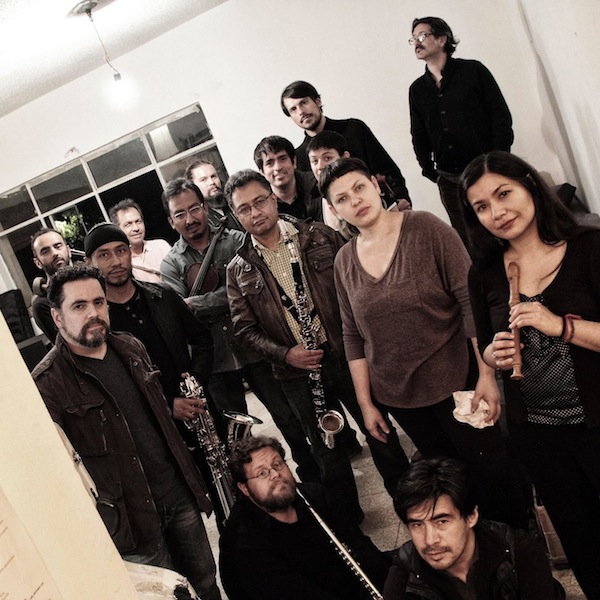From a shower to a sweatshop, MATA Festival opens with a dizzying range of music

Liminar performed at the MATA Festival Tuesday night. Photo: Karla González Treviño
When the MATA Festival is at its best, as it has been under the tenure of current artistic director Du Yun, it presents a broader range of contemporary musical ideas than any other such event.
That also means that not all the music on every concert will succeed. MATA presents what composers and musicians are exploring, and not every path will be fruitful nor every experiment successful. MATA courts failure, which is an absolutely necessary condition for a creative art to remain relevant. One crazy idea that fails is worth 100 works of decadent blandness.
And so Tuesday night’s opening concert for the Mainstage portion of the 2018 festival was a success, even though not all the music worked. In fact it was a fascinating evening overall, even with a three-hour length and some very slow setups and changeovers.
Liminar, an impressive new music group from Mexico making their East Coast debut at the Kitchen, played seven works from seven different composers, including three world premieres and two MATA commissions. (The festival has one from a new composer and one from an alum slated for each concert.). Each of the seven was different in philosophy, aesthetic, and method from the others, the consistency being that most of the music was reaching outside its own boundaries.
D-Musik by Sergey Khismatov opened–by far the most radical work on the program, and possibly the most radical work heard in New York this season. First, there was a hint; as Du Yun and executive director Todd Tarantino addressed the audience, soprano Carmina Escobar crossed the stage, took a turn, and showed off her green sequined tunic, saying “You’ll see this soon.”
This was true. The lights went down and an image came up on a screen at the back of the stage: it was Escobar, live, dressed and in a shower. Yes, she sang. Not like most of us though—the piece had her taking swigs of water and then singing long tones in a kind of pitched gargling. She followed major and minor intervals up and down, at times accompanying herself with spray from the shower head used rhythmically against the walls and the curtain.
Musically, the piece was barely anything. But D-Musik was to be seen, not heard. It was more about timbre than pitch, and much more about the demands of performance. It was about the body, not just the danger of Escobar choking—which she did once, briefly—but in how it can produce sound. To break up the long tones to make rhythms, Escobar had to move and shake her whole body to interrupt the ululating water in her throat.
One noted not just the novelty but Khismatov’s curiosity, his attitude of “what would this be like?” of trying to discover something, rather than just assuming. This value continued with Tania Rubio’s Siete Colores de la Luna. Guided by changing colored lights, the musicians worked as a sensitive collective, following and matching each other through a slowly moving cycle of pitches—this seemed the ideal musical representation of experiencing an Alexander Calder mobile. The playing was quiet and delicate, full of an excited concentration that added to the absorbing beauty of the sound.
The world premiere of MATA’s commissioned piece from Daniel Stillman, the two names, had a similar attractive delicacy and also some unusual features. Unfolding with a linear exactitude, the music laid out a progression of unrelated units, and tried to use duration to create a structure out of them. This called for an invigorating precision from Liminar.
But much of these elements were in conflict with each other. Stillman had a secondary goal, to use sound to make the listener aware of overlooked things that surround us, and that fell to percussionist Diego Espinosa. He scraped an amplified tambourine, drew a stick across the edge of a piece of plexiglass, and most prominently kept triggering a few seconds of 60Hz alternating current hum. While the acoustic percussion added color and brought to mind the Wandelweiser group, the hum interrupted everything thus demolishing any structure the mind had built. The choice was a problem; that hum is the background noise of civilization, and trying to reveal something that is all over the place was too obvious and heavy-handed for the overall gentleness of the music.
The alumna commission was a world premiere from Annie Gosfield, one of the most consistently welcome presences on concert programs. Her Voices Over the Buzz and Clatter used the idea of industry too, but where Stillman teased with the machines, Gosfield’s music was all about machines—she wrote in the program she was thinking about the sweatshop environment her grandmother worked in.
This meant a percussive attack for every instrument, unabashed rock rhythms and rough-edged orchestration. The music had the pounding regularity of machinery, and a harmonic flow that spun out melodic lines. An exemplary part of her body of work, Voices was sophisticated, sensitive, straightforward, and knew exactly how long it should run.
Duration was an issue in the concert, with D-Musik, the two names, and all the music on the second half having insufficient material to fill the time they took.
Joe Bates’ piano quartet A Noise So Loud, another world premiere, was made with brilliant material: a 24-note equal tempered scale. One of the fascinations of the piece was actually seeing cellist Jorge Amador work hard at tuning his instrument.
While the notes were avant-garde in the contemporary context, the music was presented, deliberately, as familiar tonal chamber music. The result was utterly uncanny—the ear can adapt quickly to different tunings, but not with this piece. The weird sound and neo-romantic style made it sound like a great score to a film noir. It was just too long, with two identifiable sections when one was perfect—the effect dissipated while the playing went on.
Fata Morgana, by Carlos Iturralde, was another delicate, quietly intense work. Featuring a retuned Amador, violist Alexander Bruck Santos, and bassist Juan Garcia, it was involving and quite beautiful for a while. The string players mainly used what appeared to be small rubber hemispheres on short sticks, bouncing them off the strings, tapping and rubbing them against the bodies of their instruments. The sounds were gorgeous with an inherent unpredictability that was compelling.
From behind the audience, bass clarinetist Rodrigo Garibay, baritone saxophonist Omar López, and flutist Wilfrido Terrazas used soft, long tones to match the pitches they could hear coming off the strings. This was magical. Then there was a pause, a superfluous coda, and that magic was gone.
The finale was Juro Kim Feliz’s Pangkur. Though dated 2017 (the most seasoned piece was the 2013 Siete Colores), this was conventional new music, which in this context made it almost revanchist. Built with complicated rhythms, attacks like a spray of pebbles against a window, a near hyperactive polyphony, this was the sound of the new complexity. It would have been daring on most other concerts, but here it was a strangely safe choice.
The MATA Mainstage runs through April 14 at the Kitchen, with one final concert April 21. matafestival.org
